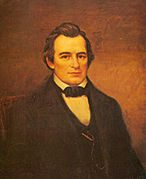Top Qs
Timeline
Chat
Perspective
1838–39 United States House of Representatives elections
House elections for the 26th U.S. Congress From Wikipedia, the free encyclopedia
Remove ads
The 1838–39 United States House of Representatives elections were held on various dates in various states between July 2, 1838, and November 5, 1839. Each state set its own date for its elections to the House of Representatives before the first session of the 26th United States Congress convened on December 2, 1839. They occurred during President Martin Van Buren's term. Elections were held for all 242 seats, representing 26 states.
The Panic of 1837 and consequent economic downturn drove Whig Party gains. Van Buren's Democratic Party had lost popularity and Whig policies of economic nationalism appealed to a larger number of voters. Democrats were able, however, to contain the political fallout by blaming banks for the crisis. The Anti-Masonic Party, influential in New York, Pennsylvania, and other Northern states, lost seats, while the Southern Nullifier Party disappeared. Two Virginia representatives were elected on that state's Conservative Party ticket.
Early business of the new House reflected the close partisan division. When Congress first Convened on December 3, 1839, two contingents of New Jersey representatives-elect, one composed of Democrats and the other of Whigs, arrived and both requested to be seated as members. Charging the Whigs with election fraud and facing loss of control of the House, the Democratic Party majority (119 to 118 Whigs from outside New Jersey) refused to seat all but one Whig.[1] Massachusetts Representative John Quincy Adams presided as "chairman" of the House after the clerk lost control. Two weeks later, when voting for speaker of the House finally commenced, 11 ballots were needed before Robert M. T. Hunter, a compromise Whig candidate, was elected, receiving 119 votes (out of 232 cast).[2] This congress also enacted the first Independent Treasury bill.

Remove ads
Election summaries
| 125 | 8 | 109 |
| Democratic | [a] | Whig |
Remove ads
Special elections
Summarize
Perspective
There were special elections in 1838 and 1839 to the 25th United States Congress and 26th United States Congress.
Special elections are listed by date then district.
25th Congress
26th Congress
Remove ads
Alabama
Arkansas
Remove ads
Connecticut
Summarize
Perspective
Connecticut elected its six members April 1, 1839, flipping all six seats from Democratic to Whig.
Remove ads
Delaware
Florida Territory
See Non-voting delegates, below.
Georgia
Illinois
Indiana
Iowa Territory
See Non-voting delegates, below.
Kentucky
Louisiana
Maine
Maryland
Massachusetts
Summarize
Perspective
Elections were held November 12, 1838, but one district's election went to a fourth ballot in 1839, after the March 4, 1839 start of the term but before the House convened in December 1839.
Michigan
Mississippi
Summarize
Perspective
A special election was held in Mississippi on July 17–18, 1837. Its winners were Democrats John F. H. Claiborne and Samuel J. Gholson. The first session of the 25th Congress was a special session beginning on September 4, 1837, extending to October 16. In November, Mississippi held the regular election. Seargent Smith Prentiss, a Vicksburg lawyer and Whig, unexpectedly launched a vigorous, partisan campaign. He and fellow Whig Thomas J. Word won in an upset. Claiborne and Gholson then argued that the July result entitled them to serve full terms. With the Whig Party newly organizing, the closely divided House, in which Anti-Masons, Nullifiers, and the Independent tended to align more with Whigs and to oppose Democrats, agreed to hear Prentiss. He spoke for nine hours over three days, packing the gallery, drawing Senators, and earning a national reputation for oratory and public admiration from leading Whigs including Senators Clay and Webster. The Elections Committee then required a third election. Scheduled for April 1838, it confirmed the November result. Both Whigs were seated in May late in the second session, also serving for the third session.
Missouri
New Hampshire
New Jersey
New York
North Carolina
Ohio
Pennsylvania
Summarize
Perspective
In the 3rd district, Charles Naylor's election was unsuccessfully contested by Charles J. Ingersoll.[32]
There were three special elections in Pennsylvania during the 26th Congress.[33] The first was in the 14th district caused by the death of William W. Potter (Democratic) on October 28, 1839. This vacancy was filled by George McCulloch (Democratic). The second was in the 22nd district caused by the resignation of Richard Biddle. This vacancy was filled by Henry M. Brackenridge (Whig). The third was in the 13th district caused by the death of William S. Ramsey (Democratic) on October 17, 1840. Ramsey had also been re-elected to the 27th Congress and so an additional special election was held the following May to fill the vacancy in the 27th Congress.
Rhode Island
South Carolina
Tennessee
Summarize
Perspective
Elections held late, on August 1, 1839.
Vermont
Virginia
Wisconsin Territory
See Non-voting delegates, below.
Non-voting delegates
25th Congress
26th Congress
See also
Notes
References
Bibliography
External links
Wikiwand - on
Seamless Wikipedia browsing. On steroids.
Remove ads


